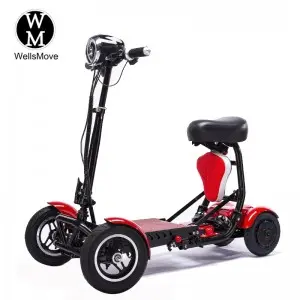A Complete Analysis of the Quality Inspection and Certification of Four-Wheeled Senior Mobility Vehicles
Amidst the global aging trend, four-wheeled mobility vehicles for seniors have become a necessity in the overseas silver-haired market. However, as mobility devices that directly impact the personal safety of users, their quality inspection and certification processes are not only a “passport” for product entry into the international market but also a crucial step for companies to build brand trust and mitigate trade risks. This article systematically reviews the core inspection items, mainstream market certification systems, and key operational points for the entire process for four-wheeled mobility vehicles for seniors, providing a complete solution for foreign trade companies, from production control to compliance and customs clearance.
1. Core Dimensions of Quality Inspection for Four-Wheeled Senior Mobility Vehicles: Comprehensive Coverage of Safety, Performance, and Durability
The testing standards for four-wheeled mobility vehicles for seniors focus on two key areas: “senior usage scenarios” and “outdoor driving environments,” addressing multiple requirements, including stability, controllability, and electrical safety. The current international testing framework primarily references the ISO 7176 wheelchair standard, the EN 12184 electric scooter safety standard, and derivative regulations from various countries. Core testing items can be divided into four categories:
(I) Safety Performance Testing: Protecting Core User Safety
Safety performance is the top priority of testing and directly determines whether a product is eligible for market approval.
Braking System Testing: This includes two types of testing: service braking and parking brake testing. Service braking requires testing the braking distance (generally required to be ≤5 meters) and the vehicle body tilt angle (≤15°) during braking on a dry concrete road at maximum speed. Parking braking requires remaining stationary on a 12° slope for 10 minutes without slipping, with the brake handle force not exceeding 30N, ensuring it is suitable for elderly users.
Steering System Testing: This involves testing the steering wheel’s free travel (required to be ≤15°), steering resistance (operating force ≤25N), and steering stability to ensure that the elderly can easily control the vehicle and that the vehicle does not stray during driving. Anti-rollover testing: The vehicle’s stability is tested on slopes with a 30° sideways tilt and a 20° forward tilt, both in the unloaded and fully loaded states. The vehicle must be stable on slopes with no risk of rollover. The trigger sensitivity and support strength of the anti-rollover wheels (if equipped) are also tested.
Electrical safety testing: Based on the IEC 60335 standard, the battery’s overcharge, over-discharge, and short-circuit protection functions are tested, as well as the charging system’s insulation resistance (≥100MΩ), leakage current (≤0.75mA), and the controller’s overload protection capabilities to prevent electrical faults from causing fire or electric shock.
(II) Performance Parameter Testing: Matching actual usage requirements
Performance testing verifies that product parameters meet the specifications in the manual and meet the requirements for daily travel for the elderly.
Power performance testing: This includes top speed (EU limit ≤6km/h, some US states allow ≤12.8km/h), gradeability (requires driving at a constant speed on a slope of ≥12°), and range (with a standard load of 75kg and on a flat road, the measured value must deviate ≤10% from the specified value). Handling Performance Testing: Tests the minimum turning radius (typically ≤1.5 meters for easy maneuvering in tight spaces) and ride smoothness (vertical acceleration of the vehicle body ≤1.5g when passing over a 10cm high speed bump) to reduce the bumpy ride for elderly passengers.
Load Performance Testing: Under the rated load (typically 100-150kg) and 120% overload, the vehicle frame deformation (≤3mm), wheel contact, and power output stability are tested to ensure that the load capacity meets the standards.
(III) Structure and Material Testing: Ensures long-term reliability
Frame Structure Testing: Verifies frame strength through static load testing (applying 3 times the rated load to key frame locations for 1 hour without permanent deformation) and dynamic fatigue testing (simulating 100,000 bumpy rides with no structural cracks). Material Environmental Protection and Durability Testing: Testing the UV aging resistance of body plastic parts (tensile strength retention ≥ 80% after 2000 hours of UV exposure), the abrasion resistance of seat fabrics (Martindale abrasion test ≥ 50,000 times), and flame retardancy (compliant with UL 94 V-0 standards); and the corrosion resistance of metal parts (no rust after ≥ 48 hours of salt spray testing).
Accessory Compatibility Testing: Testing the compatibility of core components such as batteries, chargers, and controllers to ensure that interchangeable parts from different batches can still function properly, reducing the difficulty of after-sales repairs.
(IV) Special Scenario Adaptability Testing: Coping with Complex Usage Environments
Environmental Adaptability Testing: Testing the endurance, power, and electrical performance stability in high temperature (40°C), low temperature (-10°C), and humid heat (30°C, 85% humidity) environments to meet the market demands of different climate zones. Waterproof and Dustproof Testing: According to IP protection standards, the body must meet IP54 (dustproof and splashproof), and the battery compartment must meet IP65 (completely dustproof and water-jet-proof), ensuring safe use in rainy or muddy conditions.
II. Global Mainstream Market Certification System: Targeted Compliance Solutions
Certification requirements for senior mobility scooters vary across countries and regions. Companies must plan the certification process in advance based on their target markets to avoid market delays due to compliance issues.
(I) EU: CE Certification (Mandatory) + EN Standard Compliance
The EU is one of the core markets for senior mobility scooters. Products must obtain CE certification and bear the CE mark. The core standards are EN 12184 (Safety Requirements for Electric Mobility Scooters) and 2006/42/EC (Machinery Directive). Certification Process:
Step 1: Benchmark the product design phase to the EN 12184 standard and define a list of test items.
Step 2: Commission a full test from an EU Notified Body (such as SGS, TÜV, or Intertek) and issue a test report.
Step 3: Prepare a Technical File (TCF), including product drawings, test reports, instruction manuals, and a risk assessment report.
Step 4: The Notified Body reviews the technical file and, if approved, issues a CE certificate.
Step 5: Affix the CE mark to the product, completing EU market access.
Special Requirements:
The instruction manual must be available in all 11 official EU languages and clearly indicate parameters such as maximum speed, payload, and range, as well as safety warnings.
The product must pass EMF radiation testing to ensure no interference with medical devices such as pacemakers worn by the elderly.
(II) United States: FDA Registration + DOT Compliance + ASTM Standards
The US market for mobility scooters involves two major agencies: the FDA (Food and Drug Administration) and the Department of Transportation (DOT). The core reference is ASTM F1921, “Safety Standard for Electric Mobility Scooters.”
FDA Registration (Mandatory):
Four-wheeled mobility scooters for seniors are classified as “Class I medical devices” and require establishment registration and product listing with the FDA. The process is as follows:
Apply for a DUNS number;
Submit registration information, including company name, address, and product model, through the FDA electronic portal (FDA ESG);
Pay the registration fee (approximately US$523 per year). Upon approval, a registration number will be issued, valid for one year.
DOT Compliance:
Vehicles must comply with FMVSS 108, “Standard for Motor Vehicle Lights, Reflectors, and Related Equipment,” and be equipped with headlights, turn signals, brake lights, and reflective striping;
Permanent markings such as the VIN (Vehicle Identification Number), manufacturer information, and load rating must be included on the vehicle body. Voluntary Certification: You can apply for UL certification (such as UL 2272, Safety Standard for Electric Mobility Scooters) to enhance market competitiveness. The certification process takes approximately 3-6 months.
(III) Japan: JIS Certification + Medical Device Registration
Japan’s senior market has strong demand, but certification requirements are stringent, primarily based on JIS T 9201, the “Electric Wheelchair Standard.”
Medical Device Registration (Mandatory):
Products must complete “Medical Device Registration” with the Ministry of Health, Labour and Welfare of Japan. The process is as follows:
Entrust a local Japanese certification body (such as the JIS Certification Association or Mitsubishi UFJ Testing) to conduct testing;
Submit registration application materials, including the test report, product manual, and quality management system certification (such as ISO 13485);
After review and approval, the Ministry of Health, Labour and Welfare will issue a registration certificate, valid for 5 years.
JIS Certification (Voluntary, Recommended):
After passing JIS T 9201 certification, you can affix the JIS mark to enhance your recognition in the Japanese market. The certification process takes approximately 4-8 months.
(IV) Southeast Asia: Regional Certification + Local Standards
Certification requirements in Southeast Asian markets (such as Singapore, Malaysia, and Thailand) are relatively flexible, but must comply with local standards:
Singapore: Requires SPRING Singapore certification, based on SS 628 “Safety Standard for Electric Mobility Scooters,” with testing items referenced by EN 12184;
Malaysia: Requires product certification with SIRIM (Malaysian Institute of Standards and Industrial Research), submitting a test report and factory audit documentation;
Thailand: Requires TISI (Thai Industrial Standards Institute) certification, requiring product compliance with TIS 1625-2558, and requires local sampling testing.
III. Key Points for Practical Certification Process: Risk Management from Production to Customs Clearance
(I) Early Stage: Avoiding Compliance Risks During the Design Phase
Benchmarking Target Market Standards: Initially, clarify the target market’s certification requirements (e.g., EU CE certification requires compliance with EN 12184, US ASTM F1921), and incorporate key parameters such as braking distance and steering resistance into the design to avoid costly adjustments later. Selecting Compliant Suppliers: Core components (batteries, controllers, and brakes) must be sourced from internationally certified suppliers (e.g., batteries must possess UN38.3 transport certification and IEC 62133 safety certification), and documentation of their compliance is required.
(II) Mid-Term: Efficiently Implementing Testing and Certification
Selecting Authoritative Testing Agencies: Prioritize those with recognized qualifications in the target market (e.g., EU Notified Bodies, US UL Authorized Laboratories) to avoid retesting due to non-recognition of test reports.
Optimizing Technical Documentation: Technical documentation must fully cover the product design, testing, and production processes. Risk assessment reports must include a detailed analysis of potential risks such as “brake failure” and “battery fire,” along with their corresponding countermeasures, to ensure compliance with the certification body’s audit requirements.
Response to Inspection and Corrective Actions: If an inspection fails, product adjustments must be made based on the inspection agency’s corrective recommendations (e.g., optimizing the brake system structure, replacing high-insulation wiring), and targeted retesting must be conducted to shorten the certification cycle.
(III) Post-Production: Customs Clearance and Market Maintenance
Customs Clearance Document Preparation: Export products must include certification certificates, test reports, copies of technical documents, and other materials to ensure rapid customs inspection.
Compliance Labeling: The product body must be clearly labeled with the certification mark (such as CE, UL), manufacturer information, and safety warnings (e.g., “Do not drive on motorway lanes” and “Keep away from sources of fire while charging”). The labeling must be consistent with the certification documents.
Ongoing Compliance Monitoring: Monitor updates to target market standards (e.g., the EU may revise EN 12184′s EMF testing requirements) and promptly upgrade product certifications to avoid product withdrawal due to standard changes.
Post time: Sep-12-2025



